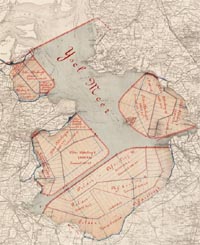Seven centuries of Zuiderzee history > Battle against the water

For centuries the inhabitants of the western parts of the Netherlands were engaged in a fierce battle against the water. Already in medieval times they built dikes to stem the water. Simple sluices served to drain off the excess water. They were opened at low tide, and closed at high tide.
From about 1400 AD onwards the Dutch built wind drainage mills. This enabled them to reclaim land from lakes. Since then, numerous polders have been recovered permanently on the turbulent water. At first, these polders merely served as protection against the sea. The polders prevented large areas of land from being washed away by the water during storms. Soon though, they formed a welcome extension of arable land.
Later on, technologies became more sophisticated, giving rise to more ambitious plans. Already in the eighteenth century the suggestion was brought forward to impolder the Zuiderzee in order to stem the force of the water. Not until 1932 the Afsluitdijk (IJsselmeer Dam) was to avert the danger of flooding once and for all.
Prints, maps, picture postcards and paintings are on view here, illustrating the Zuiderzee land reclamation works, flood disasters and the development of the district water boards. A collection of engraved glass, originating from the district water boards, is also included.
The drawings and paintings by the artist Johan Hendrik van Mastenbroek (1875-1945) and the slides by photographer C. Verkerk deserve special mention. They give quite a good picture of the Zuiderzee land reclamation works.
